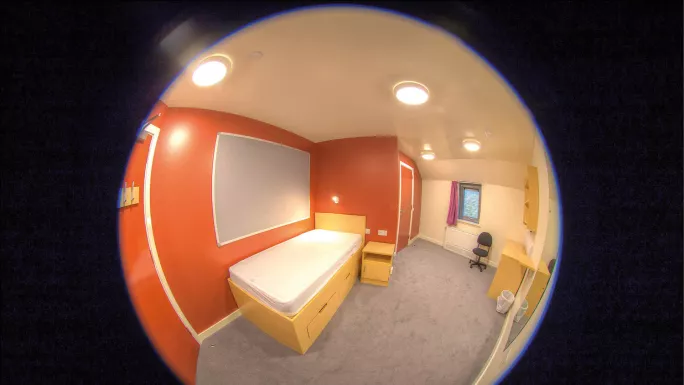The £56m school reboot giving students the ‘ultimate high’

Ythan Shaw, who is 14 years old, is getting used to his new commute. It is a five-minute walk to the new £56 million Anderson High in Shetland from the residence where pupils such as Ythan, from remote and rural parts of the archipelago, stay during term time. Previously, the hostel he lived in was part of the school so he could pretty much fall out of bed and into class, but the new accommodation is located in a separate building.
“I just have to make sure I leave earlier to get to school on time,” says Ythan, who is in S3. The new residence is “a lot more sophisticated than the old one”, adds Ythan, who flies home to Fair Isle - sometimes described as Scotland’s most remote island - with four other pupils, including his sister, Raven, every third weekend. “It uses fingerprint access to get into the building and onto the floors,” he says, by way of example.
There is space for 100 pupils in the residence, with around 60 staying there currently in a mix of single and twin rooms - there’s even a flat for parents so they can come and visit.
Ythan chooses to share a room with a pupil from another island, Unst. He likes the company, he explains. He was “emotional” when he first became a boarder at the secondary in Lerwick, Shetland’s capital, which has 900 pupils. Fair Isle Primary, in contrast, had just four pupils when he left. However, he quickly adjusted, he says.
“I was quite lucky, because when I came out, I had two siblings who were also in the residence,” says Ythan. “That helped a lot.”

The new Anderson High and halls of residence were completed in October and constitute the biggest building project that Shetland Council has ever undertaken.
It was in the spotlight last week at the Education Buildings Scotland conference in Edinburgh, an event billed as providing “inspiration” in the design of new schools, with the Scottish government hailing the halls of residence as the type of “innovative feature” that would help pupils “thrive...regardless of where they live in Scotland”.
But it has been a long time coming - the Shetland school was described at the conference as “the realisation of a 20-year dream”.
The original Anderson High building is 155 years old and listed. It was built by Arthur Anderson, who hailed from Shetland and was co-founder of P&O Ferries. But the building had become unfit for purpose. Extensions were added - in the 1960s, 70s, and 80s - and to change classes, pupils sometimes had to change buildings. Depending on where a teacher worked, they might rarely see colleagues who taught other subjects.
For this reason, it is the atmosphere in the new school that S5 pupil Khaelem Watt highlights as being his favourite thing about the new build - that and the glistening PE facilities housed in the neighbouring Clickimin Leisure Complex.
Meanwhile, principal teacher of science Claire Reid says she now sees some colleagues three times a day, whom she previously saw only three times a week. “It’s funny how a building can bring a school together,” she says.

Shetland Islands Council’s director of children’s services, Helen Budge, can see the new school from her office window and has watched it rise up from the ground until, finally, teachers cars started to pull into the car park. Pupils had yet to arrive in the new building when she spoke to Tes Scotland - that would be the “ultimate high”, she said.
If it hadn’t been for Budge’s determination, the new school would not exist, says Sandra Laurenson, a retired NHS Shetland chief executive who was one of the main players driving forward the plans for the new school. Laurenson says: “This school is the conclusion of a 20-year aspiration. Helen was completely focused and determined that we would get this school for the young folk.”
In the process of packing, Reid, who has taught at the school for 18 years, found six different sets of plans for science labs, all of which fell through - a reminder that it has not been all plain sailing to get to this point. There were fears over funding, too. Ultimately, education secretary John Swinney, who was finance secretary at the time, had to be approached to give the project special sign-off after changes to the way in which public buildings were funded put the building at risk.

There was also wrangling over the best site for the school and the council struggled to find a contractor willing to carry out the work, given the perceived difficulties of building in Shetland. All the materials had to be brought to the island by ferry and there were also worries about where workers would be housed.
The Shetland Gas Plant - said to be the biggest construction project in the UK since the London Olympics - was ongoing at the time the school build was due to get underway. There was “not a bed to be found” on the islands, says Laurenson.
“Contractors were worried about how they would accommodate their workforces,” she recalls. The gas-plant workers were eventually accommodated in barges anchored at the pier, which freed up space for the workers building the school and residence.
Now, the project has been delivered on time and on budget. Already, the school feels like home, says Valerie Nicolson, who has been Anderson High headteacher for 13 years and is a former pupil.
Like a lot of Anderson High staff, she had, after so many false starts, pushed the idea of a new school to the back of her mind. But now she has settled into her new office, which looks out over a Pictish broch - an Iron Age roundhouse building maintained by Historic Scotland - as well Clickimin Loch and the south harbour. It is not uncommon to see otters making their way from the loch to the sea - another reminder this is a school site like no other in Scotland.
“It feels right - it feels like ours,” she says.

You need a Tes subscription to read this article
Subscribe now to read this article and get other subscriber-only content:
- Unlimited access to all Tes magazine content
- Exclusive subscriber-only stories
- Award-winning email newsletters
Already a subscriber? Log in
You need a subscription to read this article
Subscribe now to read this article and get other subscriber-only content, including:
- Unlimited access to all Tes magazine content
- Exclusive subscriber-only stories
- Award-winning email newsletters